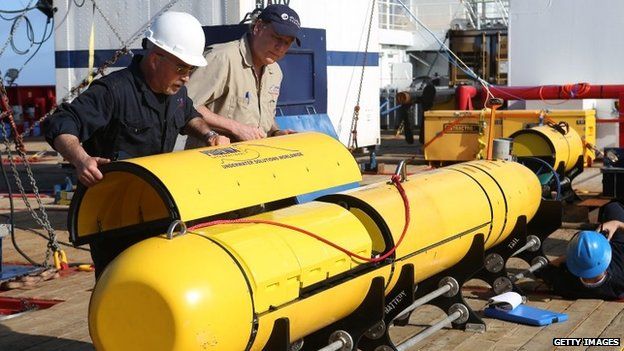Malaysia missing plane: Mini-sub completes third search mission
- Published

A mini-submarine searching for the missing Malaysian plane has completed a full mission at its third attempt.
Two previous missions to scour the floor of the Indian Ocean for wreckage were cut short by technical problems.
The data from the sub's latest mission is being analysed. Previous forays have not shown anything significant.
It is searching in the area acoustic signals thought to be from the missing plane's "black box" flight recorders were heard.
Malaysia Airlines flight MH370 disappeared on 8 March as it flew from Kuala Lumpur to Beijing. It was carrying 239 people.
Using satellite data, officials have concluded that it ended its journey in seas west of the Australian city of Perth.
They do not know why the plane flew so far off course and finding the plane's flight recorders is seen as key to understanding what happened.
Operating depth
The Bluefin-21, operated by the US Navy off the Australian vessel Ocean Shield, is an autonomous underwater vehicle (AUV) that can identify objects by creating a sonar map of the sea floor.
It is searching in an area defined by four acoustic signals picked up by an Australian search team, and was deployed after officials concluded that the batteries on the plane's flight recorders would likely have expired, given their one-month shelf life.
The submersible has an operating depth of 4,500m (15,000ft) and on its first mission a built-in safety device returned it to the surface after it exceeded that depth.
Its second mission was also cut short because of unspecified technical difficulties, but the third mission - a full 16 hours, plus two hours each way for diving and surfacing - went according to plan.
"Overnight Bluefin-21 AUV completed a full mission in the search area and is currently planning for its next mission," the Joint Agency Co-ordination Centre (JACC) said in a statement.
"Bluefin-21 has searched approximately 90 sq km to date and the data from its latest mission is being analysed."
Later on Thursday, the JACC said the Bluefin-21's manufacturer had advised that the machine could operate deeper than 4,500m at "a small but acceptable level of risk".
As a result, the submersible could now operate "within the predicted limits of the current search area", it said, without specifying how deep the Bluefin-21 would be sent.
An sample from an oil slick in the area the acoustic signals were heard in was sent to Perth for testing. However, the JACC confirmed on Thursday that the oil sample was not aircraft engine oil or hydraulic fluid.
Officials have warned that the search for wreckage on the sea floor could take weeks or months.
Speaking to reporters, Malaysia's Acting Transport Minister Hishammuddin Hussein said: "There will come a time when we need to regroup and reconsider, but in any event, the search will always continue. It's just a matter of approach."